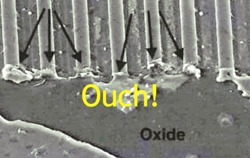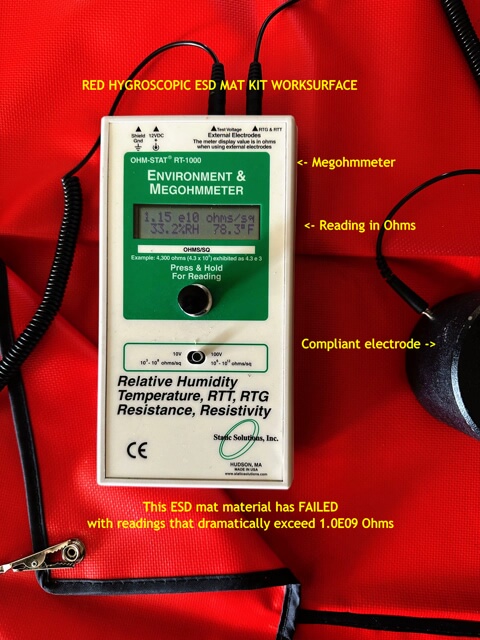 UNITED Static Control Products Contact us | Telephone 719 676 3928 | Search |
|
ESD Mat KitsSingle layer homogenous, 2 layer rubber, 3 layer vinylHow they work, what to avoid and how to achieve COMPLIANCE
An ESD mat kit in its most basic form consist of a worksurface (an ESD mat), a common point ground connection, and an ESD wrist strap. In this study we'll show you what to look for, what to avoid and how to test the assembly. We'll also cover the compliance that you'll want to achieve to successfully implement the outstanding static control properties provided by a properly functioning kit.
Why Are They Needed? ESD mat kits are normally the first line of defense in protecting static sensitive product from becoming damaged by the immediate discharge of an electrostatic "event." These events are most typically user induced and are a byproduct of the contact and separation of a technician in concert with their clothing and footwear rubbing against their skin. It's RARE for a technician to feel a static discharge. A static discharge happens well below the threshold of human perception (around 3,500 volts). Sadly, many sophisticated micro components feel this discharge at a much lower voltage as it blows through the insulative layers that are the basis of many electronic components. The damage can be catastrophic (these are easy to catch). But, in most cases, the damage is latent (hidden and not fully developed). A component is simply weakened. This failure mode is the bane of electronic manufacturing. The device works great at the factory. Why oh why does is fail in the future? Two words: Static discharge! Hence, static protection is a must and an effective ESD mat kit can provide an amazing amount of protection for very little money. This is why the electronic manufacturing industry has set stringent standards on the work surface performance in the form of ANSI/ESDS20.20-2021 table 3. Two criteria MUST be met: PRODUCT QUALIFICATION per ANSI-ESD STM4.1: The ESD work surface mat is tested at various levels of humidity (some as low as 12%) using a megohmmeter and specialty electrodes. The megohmmeter generates a 100 volt charge and the device measures the electrical resistance in ohms. Product Qualification is normally done by the manufacturer of the matting. COMPLIANCE VERIFICATION Per TR-53: The ESD work surface mat is tested by the end user (client) using a megohmmeter and specialty electrodes. The megohmmeter generates a 100 volt charge and the device measures the electrical resistance in ohms. Make no mistake: If the ESD work surface does NOT pass "product qualification" the chances of it providing any meaningful static control properties are highly unlikely. Note: In both test methods if the mat comes in below 1 billion ohms (1.0E09) it passes! If it comes in ABOVE 1 billion ohms (1.0E09) it FAILS! ESD worksurface mats come in 4 distinct forms (click links for nuances):
EVALUATION AND TESTING: In this study we've tested these assemblies for compliance to ANSI ESD S20.20-2021, page 8, table 3 "Worksurface" Product Qualification and Compliance Verification per ESD TR-53. All were promoted as being compliant to ANSI ESD S20.20-2021 and all are very popular. The hardware supplied with the kits is easily tested with a standard volt ohm meter. As expected, the electrical resistance of the ground cords and wrist straps met industry expected standards with an electrical resistance (measure in ohms) of about 1 megohm. The static conductance of the work surfaces varied dramatically. The first 3 samples tested well and easily met the new standards. In all three cases, when the mats were attached to electrical ground a 3,000 volt charge was eliminated in under 0.1 seconds. The 4th example did not meet the latest standards in electrical conductance.
It is a homogenous "hygroscopic" vinyl that contains a special chemical additive designed to absorb the ambient humidity in the environment for its static conductance. NOTE: Water vapor in high concentrations are conductive. Hygroscopic chemicals absorb humidity slowly. If the humidity is sustained at a high enough level (think greater than 65% rH for well over 7 days) the mat may be able to pass compliance verification. But . . . ESD mats made of this hygroscopic vinyl will NEVER pass the "Product Qualification" of ANSI ESD S20.20-2021. Why? The mat must perform at 12% relative humidity! This mat has dramatically failed even at 33%. What makes matters worse is this material generates and holds a static charge of around 223 volts when the mat is not attached to an electrical ground. The maximum static voltage for most ESD control areas is 100 volts. Do all hygroscopic mats have the same issue with static conductance? Although this study was limited to testing 5 of the most popular hygroscopic ESD mat kit offerings, none passed the Product Qualification or Compliance Verification in our labs located in Colorado or Florida. CONCLUSION:
Contact UNITED Static Control Products Inc © 1996 - 2025 All rights Reserved 06/03/2025 w3c compliant * |
||||

